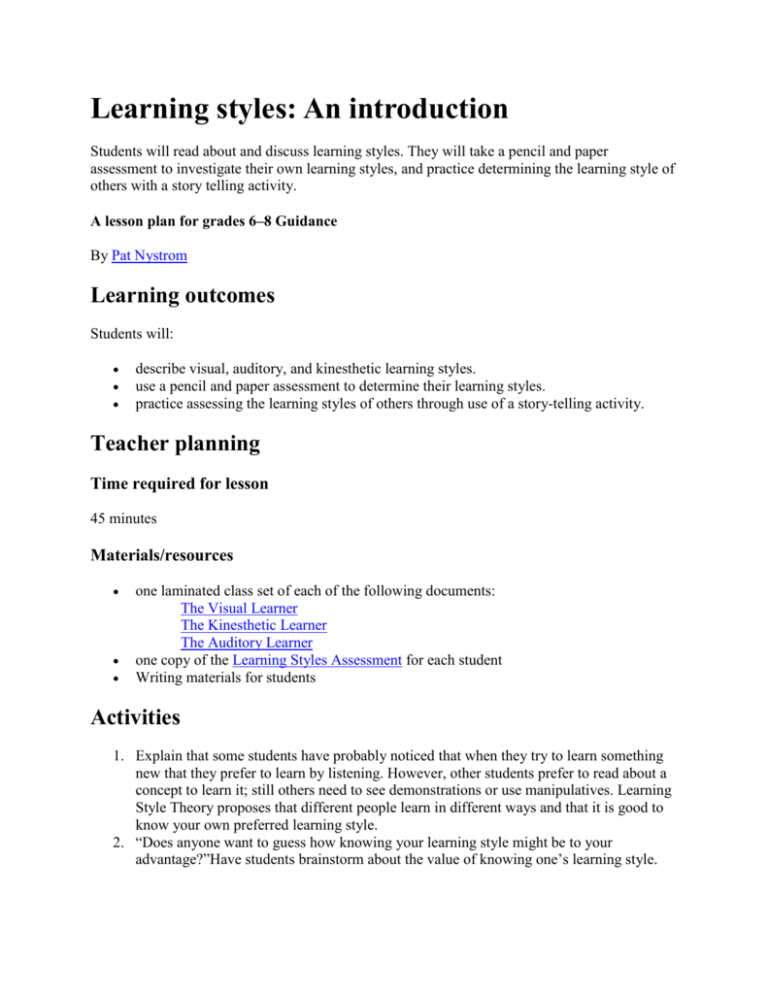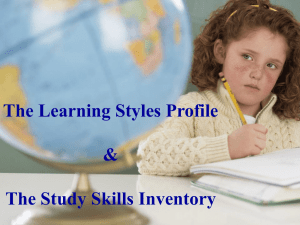Learning styles an introduction
advertisement

Learning styles: An introduction Students will read about and discuss learning styles. They will take a pencil and paper assessment to investigate their own learning styles, and practice determining the learning style of others with a story telling activity. A lesson plan for grades 6–8 Guidance By Pat Nystrom Learning outcomes Students will: describe visual, auditory, and kinesthetic learning styles. use a pencil and paper assessment to determine their learning styles. practice assessing the learning styles of others through use of a story-telling activity. Teacher planning Time required for lesson 45 minutes Materials/resources one laminated class set of each of the following documents: The Visual Learner The Kinesthetic Learner The Auditory Learner one copy of the Learning Styles Assessment for each student Writing materials for students Activities 1. Explain that some students have probably noticed that when they try to learn something new that they prefer to learn by listening. However, other students prefer to read about a concept to learn it; still others need to see demonstrations or use manipulatives. Learning Style Theory proposes that different people learn in different ways and that it is good to know your own preferred learning style. 2. “Does anyone want to guess how knowing your learning style might be to your advantage?”Have students brainstorm about the value of knowing one’s learning style. 3. Each student receives three handouts on learning style. Read over each list of learning style characteristics with the class. Ask “Now that you know about the behaviors that go with each learning style, did you find a learning style that seems to describe you?” 4. Have students guess whether their learning style is visual, auditory, or kinesthetic. They can guess out loud, one at a time, or raise hands when you ask “Who thinks they may be a visual learner? An auditory learner? A kinesthetic learner?” 5. Hand out Learning Styles Assessments, ask students to put names on them and ask students to complete and score them. The class can read aloud if it speeds things up. All students should write results of the assessment at the bottom of the second page. Explain that this assessment was only one opinion and that the class will do other assessments online the next week to get more information. 6. Ask the class whether they understand the learning styles concept well enough to be able to figure out the learning styles of others. If they think so, students can volunteer to relate a story and classmates will observe while they talk, looking for clues to learning style. o Does the student use noises or voice inflections to help tell the story? Do they imitate noises? Repeat who said what? Mention how things sounded? (Auditory?) o Does the student tell about colors, sizes, appearances? Do they use their hands to draw pictures in the air as they talk? Try to give you mental pictures? (Visual?) o Does the student relate the action in the story without much visual or auditory detail? Tell about feelings? Move around to act out things? (Kinesthetic?) 7. Each volunteer will tell a story while classmates observe and guess learning styles after the story. Pay close attention yourself to be of help during the guessing. 8. If most classmates think the story-teller is a _____ learner, have the student add that opinion to the information on the scoring sheet. 9. After making sure student names are on pencil and paper assessments, collect the papers to take them yourself to the computer lab the following week. 10. Compliment students on cooperative behavior or good thinking you observed during the class. Suggest that they practice assessing the learning styles of other people during the week. Assessment Assessment can take place during the story-telling activity used in this lesson. Students will have to apply their understanding of learning style concepts to make valid observations and comments. North Carolina curriculum alignment Grade 6–8 Goal 1: Acquire the attitudes, knowledge and skills that contribute to effective learning in school and across the life span. Objective 1.09: Apply knowledge of learning styles to school performance. Objective 1.12: Develop an awareness of personal interests, skills, motivations, and abilities.







